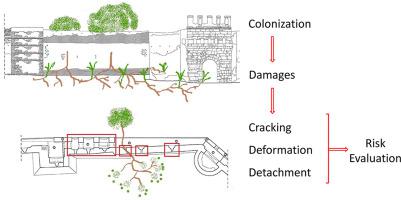当前位置:
X-MOL 学术
›
Int. Biodeterior. Biodegrad.
›
论文详情
Our official English website, www.x-mol.net, welcomes your feedback! (Note: you will need to create a separate account there.)
Colonization and damages of Ailanthus altissima (Mill.) Swingle on archaeological structures: Evidence from the Aurelian Walls in Rome (Italy)
International Biodeterioration & Biodegradation ( IF 4.8 ) Pub Date : 2020-09-01 , DOI: 10.1016/j.ibiod.2020.105054 G. Trotta , V. Savo , E. Cicinelli , M. Carboni , G. Caneva
International Biodeterioration & Biodegradation ( IF 4.8 ) Pub Date : 2020-09-01 , DOI: 10.1016/j.ibiod.2020.105054 G. Trotta , V. Savo , E. Cicinelli , M. Carboni , G. Caneva

|
Abstract Ailanthus altissima is an extremely aggressive and globally invasive species. This tree has ideal growing conditions in ruderal areas, and is difficult to manage, as cutting is a trigger for the sprouting of new suckers. Despite the wide literature on the negative impacts of this species, measurements of its interaction with archaeological monuments are lacking. We analyzed its colonization behavior and the caused damages along the Aurelian Walls in Rome, which resulted in detachments, crackings and deformation. Our results highlighted the rapid growth potential and wide distribution of this tree in the site (48 nuclei with 578 stems, mainly root suckers, along 7.1 km of 12.5 total length). Our study also provides a quantitative assessment of the damaging potential of A. altissima, as, in 16 out of 48 nuclei, we detected visible damage to the walls, which were likely due to both mechanical and chemical interactions through acidic exudates. The damages correlated significantly with plant size but not with plant distance from the walls, likely due to the wide lateral spread of the roots. This work highlighted the need to monitor and contain A. altissima, but also offers a general approach for the assessment of risks to monuments by higher plants.
中文翻译:

臭椿 (Mill.) 在考古结构上摇摆的定植和破坏:来自罗马(意大利)奥勒良城墙的证据
摘要 臭椿是一种极具侵略性和全球入侵性的物种。这棵树在荒凉地区具有理想的生长条件,并且难以管理,因为切割是新吸盘发芽的触发因素。尽管有大量关于该物种负面影响的文献,但缺乏对其与考古遗迹相互作用的测量。我们分析了它的殖民行为以及沿罗马奥勒利安城墙造成的损坏,导致分离、开裂和变形。我们的结果强调了该树在该地点的快速生长潜力和广泛分布(48 个核,578 个茎,主要是根吸盘,总长 12.5 公里,长 7.1 公里)。我们的研究还对 A. altissima 的破坏潜力进行了定量评估,因为在 48 个细胞核中的 16 个中,我们检测到墙壁有明显的损坏,这可能是由于酸性渗出液的机械和化学相互作用造成的。损害与植物大小显着相关,但与植物与墙壁的距离无关,这可能是由于根部的广泛横向扩展。这项工作强调了监测和遏制 A. altissima 的必要性,但也为评估高等植物对古迹造成的风险提供了一种通用方法。
更新日期:2020-09-01
中文翻译:

臭椿 (Mill.) 在考古结构上摇摆的定植和破坏:来自罗马(意大利)奥勒良城墙的证据
摘要 臭椿是一种极具侵略性和全球入侵性的物种。这棵树在荒凉地区具有理想的生长条件,并且难以管理,因为切割是新吸盘发芽的触发因素。尽管有大量关于该物种负面影响的文献,但缺乏对其与考古遗迹相互作用的测量。我们分析了它的殖民行为以及沿罗马奥勒利安城墙造成的损坏,导致分离、开裂和变形。我们的结果强调了该树在该地点的快速生长潜力和广泛分布(48 个核,578 个茎,主要是根吸盘,总长 12.5 公里,长 7.1 公里)。我们的研究还对 A. altissima 的破坏潜力进行了定量评估,因为在 48 个细胞核中的 16 个中,我们检测到墙壁有明显的损坏,这可能是由于酸性渗出液的机械和化学相互作用造成的。损害与植物大小显着相关,但与植物与墙壁的距离无关,这可能是由于根部的广泛横向扩展。这项工作强调了监测和遏制 A. altissima 的必要性,但也为评估高等植物对古迹造成的风险提供了一种通用方法。



























 京公网安备 11010802027423号
京公网安备 11010802027423号